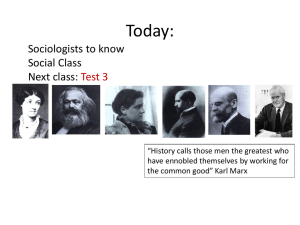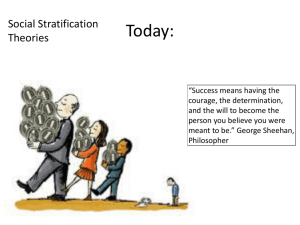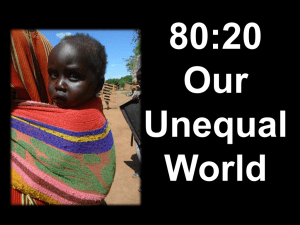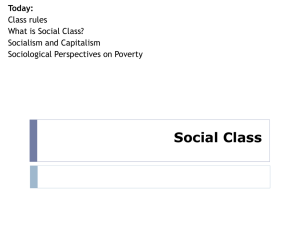Functionalist Perspective
advertisement
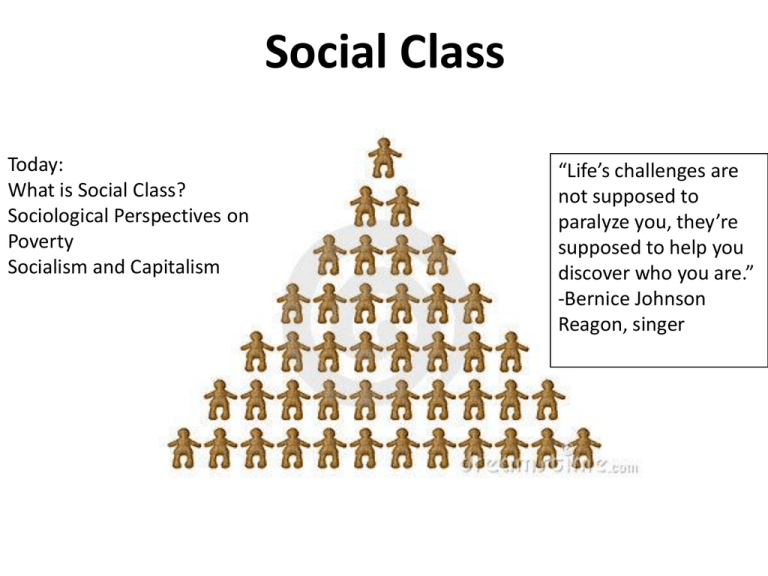
Social Class Today: What is Social Class? Sociological Perspectives on Poverty Socialism and Capitalism “Life’s challenges are not supposed to paralyze you, they’re supposed to help you discover who you are.” -Bernice Johnson Reagon, singer Test # 3 19. The article So Sexy So Soon discusses a 7 year old girl who: a) Asks her mother if she can get breast implants b) Thinks she is too fat c) Has a mother who thinks it is fine for her daughter to have a boyfriend d) Has a mother who allows her to wear make-up, high heels, and mini-skirts 20. Your text explains how gender roles vary. One example given is of: a) Boys in western Africa carrying mirrors, fixing their hair, and putting on eyeliner. b) Girls in the United States who play football in high school. c) Polyandry (the practice of one woman having multiple husbands) in ancient Tibet d) Sexual harassment by female bosses of male employees What is social class? Max Weber: people who rank closely to one another in terms of: class/wealth Property and income minus debt 1864-1920 power Ability to get others to do what you want prestige Level of respect an individual or their position demands Status consistent vs. Status inconsistent Rank equally on all = Status Consistent Status inconsistent =not equal on all 3 measures of class class/wealth power prestige Property and income Ability to get others Level of respect an minus debt to do what you want individual or their position demand What is social class? • Karl Marx: a system of “haves” and “have-nots” • based on the means of production • 2 classes: bourgeoisie and proletariat Lawyer who works for a firm and clients 1818 –1883 Independent cab driver who owns his taxi *Bourgeois= adjective C. Wright Mills Power Elite Key people in three major institutions of modern society, government, military, and economy. 1916-1962 Power Elite • Small group of people who control a high amount of wealth and access to decision-making of global consequence 1.“If you put your mind to it you can get from the bottom to the top.” Do you agree? Why or why not? 2. What obstacles in U.S. History existed for African Americans to obtain wealth? 3. Fair Housing Act of 1935? 4. Impact on children? 5. How does parental wealth help? How has U.S. policy influenced social stratification? View: The Way We Live. Ups and Downs of Social Stratification 9:35-17:30 The American Dream-Rags to Riches “America is the land of opportunities, anyone who works hard enough can achieve anything and accomplish any goal.” Do you agree or disagree with this statement? Why? The American Dream-Rags to Riches Horatio Alger myth: belief that due to limitless possibilities anyone can get ahead if he or she tries hard enough What is social stratification? • Institutionalized pattern of inequality • Some people get more access to resources than others • Reflecting inequalities in life chances Causes of Poverty Functionalist Perspective • Poverty persists because it performs some positive functions Causes of Poverty Functionalist Perspective Sociologist Kingsley Davis and Wilber Moore (1945) highly criticized view: • Provides society with people willing to do less desirable jobs • Provides jobs • Provides a market for lesser goods Causes of Poverty Functionalist Perspective Sociologists Kingsley Davis and Wilber Moore (1945) highly criticized view • Talents are rewarded • All positions in a society (doctors - janitors) must be filled • Poverty discourages people from neglecting their social duties Functionalist Perspective • Criticized because not all careers are rewarded for their value in society Causes of Poverty Interactionist Perspective- 1st view People get used to living in poverty Have difficulty changing the situation Criticized because it seems to “blame the victim” Symbolic Interactionist Perspective 2nd view Labels of poor: View of wealthy: •irresponsible •lazy •low motivation •low ability •low morals •capable •hard working •motivated •deserving of wealth •evil, greedy, undeserving Conflict Perspective • Karl Marx: ruling class controls the economic system for its own benefit • Exploits and oppresses the masses Conflict Perspective Occupy Wall Street Protests http://www.youtube.com/watch?v=Zgr3DiqWYCI Extra Credit Opportunity Video Review View Capitalism A Love Story Michael Moore If you agree with Conflict Theory: Describe 3 points the film makes that support the theory If you disagree with Conflict Theory: Describe 3 counter-arguments you have to points made in the film Which explanation of poverty applies best to today’s economic crisis? Why? a. Symbolic Interactionist A: people get accustomed to living in poverty and therefore have difficulty changing the situation b. Symbolic Interactionist B: people in poverty get labeled as lazy and lose out on opportunities due to the label c. Structural Functionalist: poverty is a functional in society, it motivates people to seek higher rewards d. Conflict Theory: The masses are exploited by the few who have money and power Discuss your answers in groups of 2-4 Socialism and Capitalism Socialism – spread the wealth/resources evenly Economic system - means of producing goods and services are collectively owned Story of Gloria Socialism and Capitalism Capitalism – competition for wealth Economic system- private individuals or groups invest $ to produce goods and services to sell for a profit Extra Credit Opportunity Video Review View Mammoth Coming up: Next Class: Health-Read article on website College Students’ Health Causes of Poverty Functionalist Perspective Major institutions in society not functioning properly 1. bad economy Causes of Poverty Functionalist Perspective Major institutions in society not functioning properly 2. bad schools Causes of Poverty Symbolic Interactionist Perspective Culture of poverty: viewing problematic behaviors (selling drugs, dropping out of school, not having a job) as normal Causes of Poverty Functionalist Perspective Major institutions in society not functioning properly 3. family breakdown Causes of Poverty Functionalist Perspective Major institutions in society not functioning properly 4. problems with government assistance Poverty In The United States Poverty in the U.S. Almost 18 million households had trouble putting food on the table (2011) Food insecure: lacking access to sufficient food for all family members
